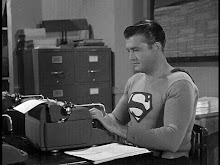 For those of you who may not know the term, this beat chart is what I will use to write the script. Essentially, it's an outline. But it's an outline that is created with index cards thumbtacked to a cork board, which makes it very easy to change things around. The writer and producers can see how the sequence works in miniature before it moves to the actual page. Sometimes when writing a feature film, each scene would have its own index card. Due to the constraints of both budget and space, however, I had to condense some of the longer sequences onto one card. But as the outline gets more and more precise, the cards will become more and more specific.
For those of you who may not know the term, this beat chart is what I will use to write the script. Essentially, it's an outline. But it's an outline that is created with index cards thumbtacked to a cork board, which makes it very easy to change things around. The writer and producers can see how the sequence works in miniature before it moves to the actual page. Sometimes when writing a feature film, each scene would have its own index card. Due to the constraints of both budget and space, however, I had to condense some of the longer sequences onto one card. But as the outline gets more and more precise, the cards will become more and more specific.Here is another, somewhat closer, view of some of the cards.
 I've never done this sort of major outline for a writing project before, but it seemed like this script was going to be a big enough endeavor that it would be a huge help to have this sort of roadmap for the story. It will be especially helpful because I want to play around with the order of events in the script timeline. For my first pass through the outline, the cards are set up to replicate the sequence of events as they occur in the novel. The next task is to look at the cards and put them in order for the radio script, which might be a different dramatic order. I've already started adjusting things, so those are the next steps in this process of adaptation.
I've never done this sort of major outline for a writing project before, but it seemed like this script was going to be a big enough endeavor that it would be a huge help to have this sort of roadmap for the story. It will be especially helpful because I want to play around with the order of events in the script timeline. For my first pass through the outline, the cards are set up to replicate the sequence of events as they occur in the novel. The next task is to look at the cards and put them in order for the radio script, which might be a different dramatic order. I've already started adjusting things, so those are the next steps in this process of adaptation.

2 comments:
I'd imagine having something physical/tangible in front of you really helps with the sorting and re-arranging, instead of relying solely on mental organization.
Not only that, but the ability to physically move the pieces around can help me see the puzzle as a whole. Even better than having something written out, which is more fixed on the page.
Post a Comment